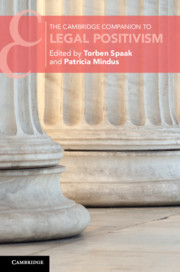Book contents
- The Cambridge Companion to Legal Positivism
- Cambridge Companions to Law
- The Cambridge Companion to Legal Positivism
- Copyright page
- Contents
- Figures
- Contributors
- Acknowledgements
- 1 Introduction
- Part I Fundamentals
- 2 Positivism, Realism and Sources of Law
- 3 Normative Legal Positivism
- 4 Legal Positivism as a Realist Theory of Law
- Part II History
- Part III Central Figures
- Part IV Main Tenets
- Part V Normativity and Values
- Part VI Critique
- Index
- References
4 - Legal Positivism as a Realist Theory of Law
from Part I - Fundamentals
Published online by Cambridge University Press: 21 January 2021
- The Cambridge Companion to Legal Positivism
- Cambridge Companions to Law
- The Cambridge Companion to Legal Positivism
- Copyright page
- Contents
- Figures
- Contributors
- Acknowledgements
- 1 Introduction
- Part I Fundamentals
- 2 Positivism, Realism and Sources of Law
- 3 Normative Legal Positivism
- 4 Legal Positivism as a Realist Theory of Law
- Part II History
- Part III Central Figures
- Part IV Main Tenets
- Part V Normativity and Values
- Part VI Critique
- Index
- References
Summary
Leiter considers the relation between legal positivism and legal realism. He argues that H. L. A. Hart’s theory of law is really a species of legal realism, and that there are four ways in which this is so, namely, that the law operates primarily outside the courts; that the law is sometimes rationally indeterminate; that the law is explicable in wholly naturalistic terms; and that the law is not necessarily morally good. He also argues that Hart’s critique of American legal realism is misguided, because Hart would fail to distinguish clearly between conceptual legal realism, which is a theory about the nature of law according to which there are no legal rules and law consists in court decisions and predictions about them, and empirical legal realism, which is a claim about how it is useful for attorneys to think about law when they advise their clients and which says that it is a mistake to think that judges (and others) are bound by legal rules. As Leiter sees it, while conceptual rule-skepticism is indeed mistaken, the Americans do not embrace it, and while they do embrace empirical rule-skepticism, this type of rule-skepticism is justified.
- Type
- Chapter
- Information
- The Cambridge Companion to Legal Positivism , pp. 79 - 102Publisher: Cambridge University PressPrint publication year: 2021
References
- 4
- Cited by

